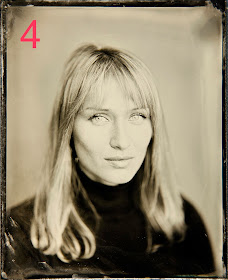Back to Petzval portrait testing today. Why? Because some folks out there have extremely strong opinions on one brand being superior to the rest and they never really back it up with anything concrete. Frankly, as I expressed in my previous lens test post, I don't agree with that point of view. Two similar lenses made by any company can be more or less sharp. A lens with no name on it at all can be sharper than your favorite (and I say that with 100% certainty from personal experience). A lens made by a manufacturer that is considered run of the mill among collectors and lens hounds can be just as sharp as a lens with similar attributes by the most renown of firms. One can sell for 1/2 as much as another and the actual performance can be better or the same. Oh, and then there's 'bokeh' argument - "this brand lens has the creamiest bokeh"... Well, let's see about it, shan't we?
Since I have 4 lenses with extremely close attributes I thought I would do a blind test and see how many people who claim to be experts in sharpness and bokeh of various lenses will be able to correctly identify which lens created which image. I encourage anyone interested in taking a closer look to download the images I'll post at the very bottom - I will upload them in full resolution there, so they'll likely be too large to be displayed properly in your browser, but you'll be able to download them and zoom in at 100% in Photoshop or Preview of whatever your favorite program is.
Here's the result of of today's labor.
Test conditions were as follows. The model was prevented from movement with the help of a head rest and I focused on the left eye using a loupe. I tightened the knobs for the movements on the camera as tight as I could without breaking the knobs - there was no tilt or swing involved, both standards were perfectly parallel. All lenses were shot wide open. All exposures were as close to 2sec as I could do while just using a cap for a shutter. Development ranged between 30 and 40 seconds (I always develop by inspection). Afterwards all 4 plates were copied with a Canon 5DII on same exposure setting, imported in Photoshop, given standard 100% sharpening with 1 pixel radius and 0 tolerance and nothing else was done with them.
Thing I was NOT focusing on in my test are - contrast and swirl. Most people shoot portrait on a plain background anyway and yes - all these lenses would indeed have a different amount of swirl should you chose to shoot for it. However the Petzval swirl can be easily controlled and if I did a test the centered around it I guarantee you I could make it just as hard to guess which lens is which.
Thing I was NOT focusing on in my test are - contrast and swirl. Most people shoot portrait on a plain background anyway and yes - all these lenses would indeed have a different amount of swirl should you chose to shoot for it. However the Petzval swirl can be easily controlled and if I did a test the centered around it I guarantee you I could make it just as hard to guess which lens is which.
So that't about it. If you care - please enter your guesses in comments below. In about a month or so I will come back to this post and edit it revealing which lens was used for each image.
The lenses I tested are pictured below and from left to right they are:
Scovill Peerless Quick Acting - 8.5in f3.3 (must mention - this one has a touch of haze)
Dallmeyer 2B - 8.5in f3.3
Voigtlander 4 - 8.5in f3.3
Darlot - 8in f3.5
Of course the pictures numbered below are not in the order that the lenses appear above - wouldn't be any fun to guess if I did that, right?
FULL RESOLUTION IMAGES
Guess away!
Anton
EDIT Feb 6th 2017










Hi Anton,
ReplyDeleteYou are totally right when you say that similar lens produces very similar images attributes, of course. But between these 4 images / lenses, I think the 1 shows a better performance than the others. In second place, at least for my taste, the 4. Best,
I like the idea of this test but the skin tones on her face where so bright it was hard to judge. I prefer low key images that could almost be described as slightly under exposed and I wonder how the different lenses handle midtones or darker.
ReplyDeleteExactly - all images are overexposed and therefore it's impossible to judge their quality. No. 1 seems to be the best of 4, but this may come from the fact that it is slightly underexposed next to the others.
DeleteThis argument falls on deaf ears for me :)
DeleteFirst off - the images are not overexposed, they are exposed very well, they are just copied while dry and yes, appear on the light side.
Secondly - her skin is very smooth to begin with.
Thirdly (and most importantly) - there is PLENTY of detail in hair and lips and the eyelashes and so on from which you can judge sharpness. Do we have to see every pore on the forehead ? lol.
I prefer to make my models look good and not shoot plates that look like case studies for local university's dermatology department.